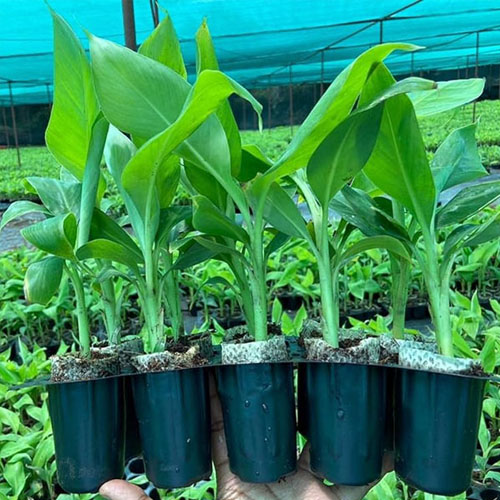G9 Banana Plants
G9 banana plants, also known as G9 Cavendish bananas, are a popular variety known for their high yield and quality fruit. Here's a detailed overview:
Description:
- Botanical Name: Musa spp. (Cavendish Group)
- Common Names: G9 Banana, Cavendish Banana
- Appearance: G9 bananas are known for their large, sturdy plants that can reach heights of about 2.5-3 meters (8-10 feet). The bananas are typically long, with a smooth, yellow skin when ripe. The plant has broad, elongated leaves and produces clusters of bananas.
Growing Conditions:
- Climate: G9 bananas thrive in tropical and subtropical climates with warm temperatures year-round. They prefer temperatures between 20°C and 30°C (68°F to 86°F) and require high humidity.
- Soil: They grow best in well-drained, fertile soils rich in organic matter. The soil should be slightly acidic to neutral, with a pH of 5.5 to 7.0. Sandy loam or loamy soils are ideal.
- Watering: Regular watering is crucial, especially during dry periods. Bananas need consistent moisture but should not be waterlogged. Draining excess water is important to prevent root rot.
Cultivation:
- Propagation: G9 bananas are typically propagated through suckers or tissue culture. Suckers are young shoots that grow from the base of the parent plant and can be separated and planted to produce new plants.
- Planting: Planting is usually done in well-prepared soil with adequate spacing to allow for their growth. The spacing should be about 2-3 meters (6-10 feet) apart. Bananas are planted in holes that are about twice the size of the root ball.
- Maintenance: Regular pruning is needed to remove dead or damaged leaves and to manage plant growth. Mulching around the base helps retain soil moisture and suppress weeds.
Uses:
- Culinary Uses: G9 bananas are widely consumed fresh and are also used in cooking and baking. They are eaten as a fruit, used in desserts, smoothies, and various dishes.
- Nutritional Benefits: G9 bananas are rich in vitamins (especially vitamin C and B6), minerals (such as potassium and magnesium), and dietary fiber. They are known for their energy-boosting properties and digestive benefits.
- Industrial Uses: Bananas are also processed into products like banana chips, flour, and juices.
Cultivation Tips:
- Pests/Diseases: G9 bananas can be susceptible to pests such as banana weevils, aphids, and nematodes. Diseases like Panama disease, Sigatoka, and black leaf streak can also affect the plants. Regular monitoring and integrated pest management are important.
- Fertilization: Bananas require regular fertilization to support healthy growth and fruit production. A balanced fertilizer with potassium, nitrogen, and phosphorus is typically used. Organic compost can also be beneficial.
- Harvesting: Bananas are harvested when they are still green but fully developed. They should be handled carefully to avoid bruising. After harvest, bananas are ripened off the plant in controlled conditions.


